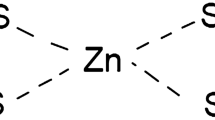Abstract
The effectiveness of a proposed solid lubricant is investigated, on the basis of the abrasive cutting coefficients. Its dependence on the grinding conditions, the characteristics of the boron-nitride wheel, and the alloying of high-speed steel is determined. The lubricant reduces the abrasive cutting coefficient by about 40–50%. A method is proposed for measuring the frictional coefficient. The benefits of lubricant application are assessed. The utility of the abrasive cutting coefficient in estimating the effectiveness of solid lubricant is confirmed.
Similar content being viewed by others
References
Vereshchagin, A.S., Voznyakovskii, A.P., Grigor’eva, T.F., et al., Progressivnye mashinostroeitel’nye tekhnologii, oborudovanie i instrumenty. Kollektivnaya monografiya (Advanced Machine Engineering Technologies, Equipment, and Tools: Collective Monograph), Moscow: Spektr, 2015, vol. 5, pp. 228–264.
Panaioti, V.A., Improvement of efficiency and quality in grinding of rapid tool steels using solid lubricants, Fundam. Prikl. Probl. Tekhn. Tekhnol., 2016, no. 2 (316), pp. 87–91.
Panaioti, V.A., Influence of solid lubricants on surface reinforcing of tools from rapid tool steel during turning, Vestn. Bryansk. Gos. Tekh. Univ., 2016, no. 2 (50), pp. 41–45.
Panaioti, V.A., Influence of solid lubricants on phase composition of grinding surface of rapid tool steels, Trudy IV mezhdunarodnoi konferentsii “Fundamental’nye issledovaniya i innovatsionnye tekhnologii v mashinostroenii” (Proc. IV Int. Conf. “Fundamental Studies and Advanced Technologies in Machine Engineering”), Moscow: Spektr, 2015, pp. 189–190.
Panaioti, V.A., Applying solid lubricant to the grinding wheel surface, Russ. Eng. Res., 2017, vol. 37, no. 4, pp. 359–362.
Kushnir, A.P., Simulation of the passage of a solid through an obstacle, Ross. Tekhnol. Zh., 2015, vol. 2, no. 4 (9), pp. 116–126.
Panaioti, V.A., Evaluation of the lubricity of a solid lubricant by the specific grinding work, Materialy VII mezhdunarodnoi nauchno-tekhnicheskoi konferentsii “Naukoemkie tekhnologii na sovremennom etape razvitiya mashinostroeniya” (Proc. VII Int. Sci.-Tech. Conf. “High Technologies at the Modern Stage of Development of Machine Engineering”), Moscow: Tekhpoligraftsentr, 2016, pp. 160–161.
Panaioti, V.A., Evaluation of lubricating ability of solid materials by coefficient of abrasive cutting, Materialy XI mezhdunarodnoi nauchno-tekhnicheskoi konferentsii posvyashchennoi 100-letiyu so dnya rozhdeniya prof. R.M. Matveevskogo “Tribologiya mashinostroeniyu” (Proc. XI Int. Sci.-Tech. Conf. Dedicated to 100th Anniversary of Prof. R.M. Matveevskii “Use of Achievements in Tribology for Machine Engineering”), Moscow: Inst. Mashinoved. im. A.A. Blagonravova, 2016, pp. 187–188.
Panaioti, V.A., Evaluation of the lubricity of a solid lubricant for the specific grinding work, Materialy VII mezhdunarodnoi nauchno-tekhnicheskoi konferentsii “Naukoemkie tekhnologii na sovremennom etape razvitiya mashinostroeniya” (Proc. VII Int. Sci.-Tech. Conf. “High Technologies at the Modern Stage of Development of Machine Engineering”), Moscow: Tekhpoligraftsentr, 2016, pp. 160–161.
Panaioti, V.A., The relief geometry of the cutting surface of the cubic boron-nitride abrasive wheels in grinding with solid lubrication, Fundam. Prikl. Probl. Tekhn. Tekhnol., 2016, no. 1 (315), pp. 67–71.
Panaioti, V.A., Structural transformations in rapid tool steels during grinding using solid lubricants, Avtom. Sovrem. Tekhnol., 2017, no. 2, pp. 56–60.
Panaioti, V.A., Effect of a solid lubricant on the surface hardening of tools from rapid tool steel by cubic boronnitride abrasive wheels with various grain sizes, Fundam. Prikl. Probl. Tekhn. Tekhnol., 2017, no. 2 (322), pp. 106–109.
Pankov, V.L., Efficiency of stimulation mechanism and potential level for satisfaction of the employee’s needs, Ross. Tekhnol. Zh., 2015, vol. 1, no. 4 (9), pp. 288–291.
Author information
Authors and Affiliations
Corresponding author
Additional information
Original Russian Text © V.A. Panaioti, Yu.S. Asadova, M.V. Nemenko, 2017, published in STIN, 2017, No. 12, pp. 31–35.
About this article
Cite this article
Panaioti, V.A., Asadova, Y.S. & Nemenko, M.V. Assessing the Effectiveness of Solid Lubricants. Russ. Engin. Res. 38, 493–497 (2018). https://doi.org/10.3103/S1068798X1806014X
Published:
Issue Date:
DOI: https://doi.org/10.3103/S1068798X1806014X




